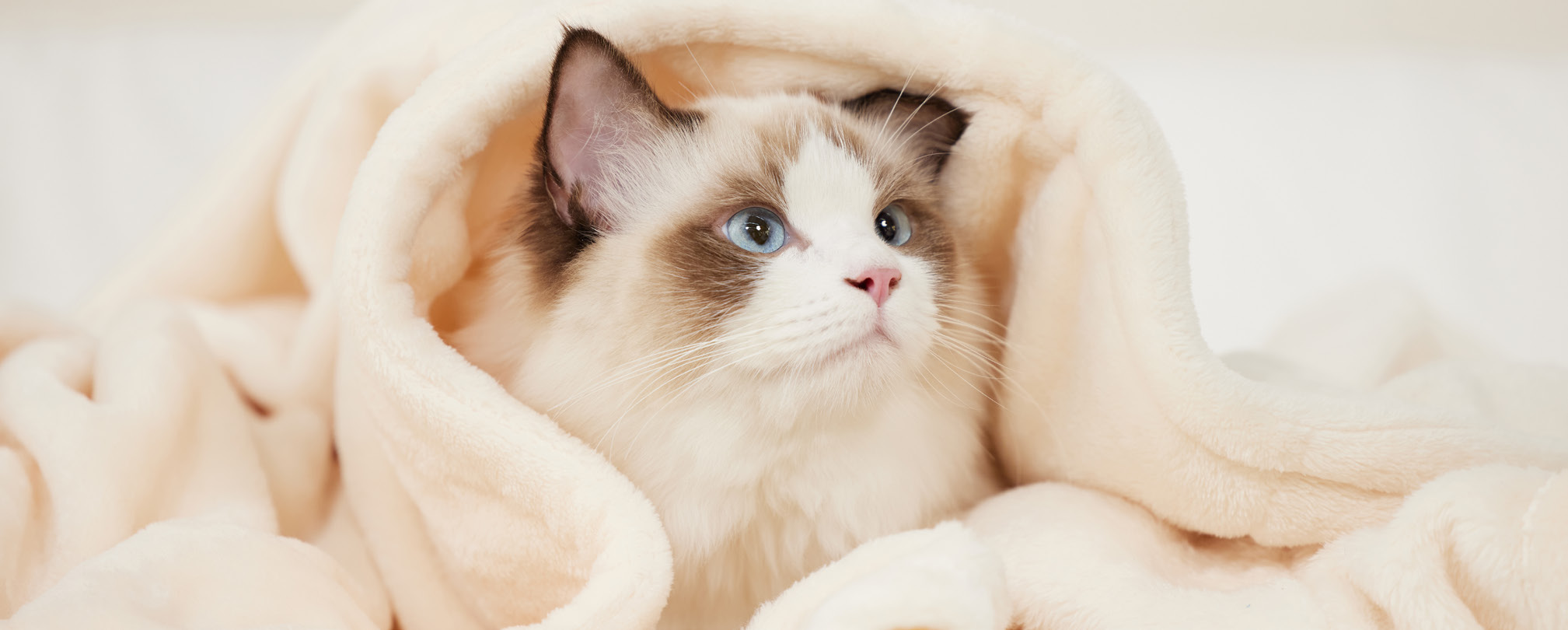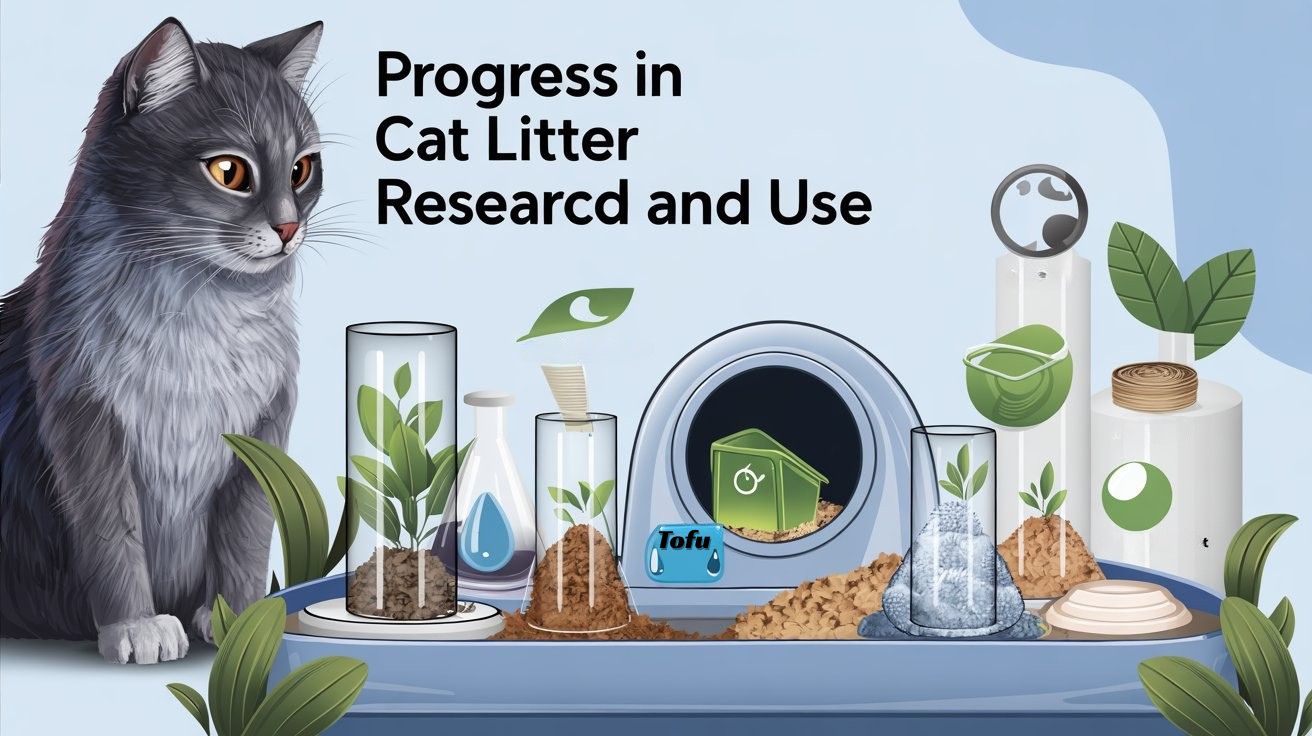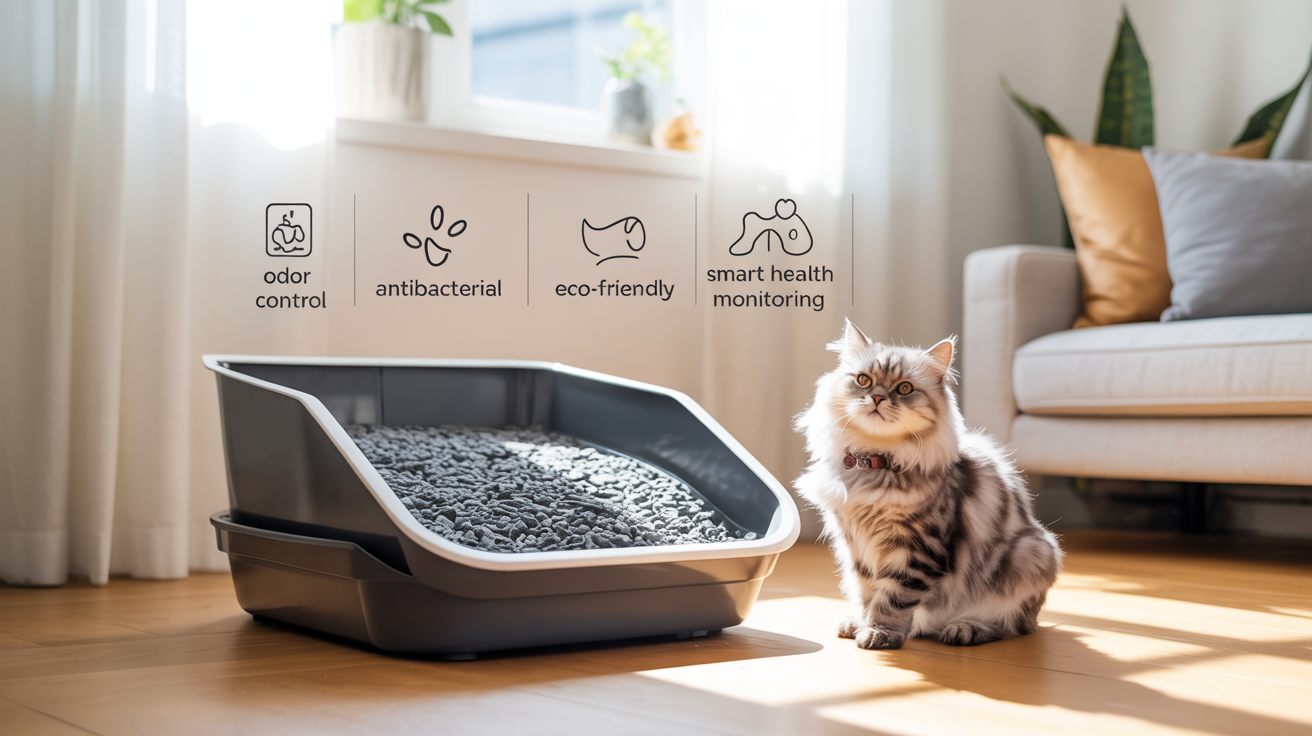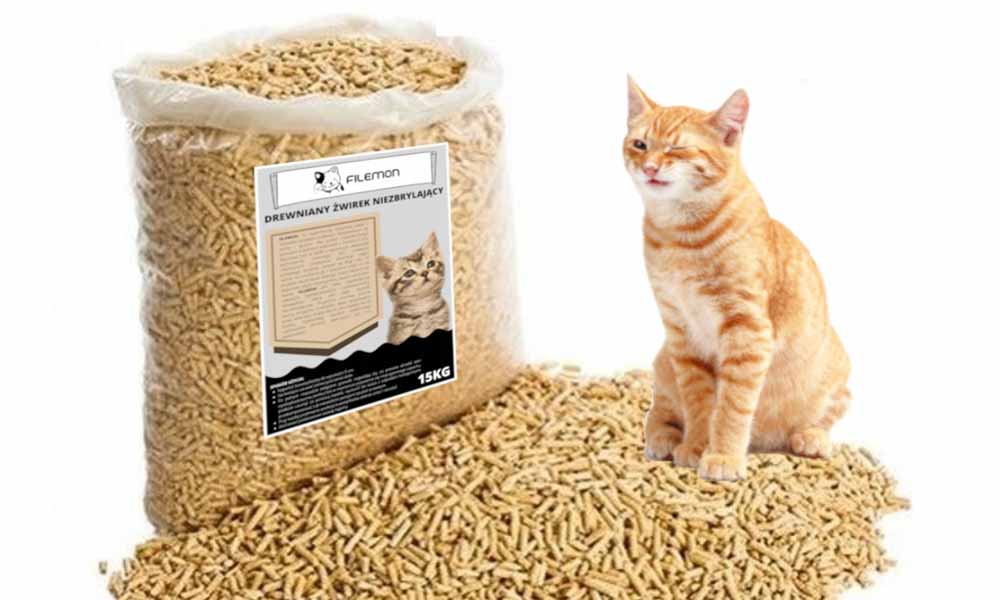In recent years, cat litter as a pet product has brought convenience to families with indoor pets. There are many types of cat litter on the market, and the research and innovation of cat litter is also deepening. This paper elaborates on the research related to cat litter from the background, types and characteristics, performance and quality improvement of cat litter, to provide a reference for the performance improvement and development of cat litter.
Introduction
Cat litter was first created in the United States in 1947 by Edward Lowe. He discovered that a type of clay used in industry could absorb cat waste. This made it easier for people to keep cats indoors while keeping their homes clean. Cat litter is now a common pet product used with litter boxes to manage pet waste, especially for cats.
In the beginning, cat litter was not very effective—it would harden at the bottom and had to be changed often. But in 1980, a scientist named Thomas Elson improved cat litter by using bentonite clay. This made the litter clump when it got wet, so people only had to scoop out the clumps, making cleanup much easier.
As more people began to own cats, especially in cities, the demand for cat litter increased. A report showed that in 2022, there were over 65 million pet cats in Chinese cities, and the market for cat products grew by 16.1%, reaching over 123 billion RMB. Cat litter is now a must-have item, with a usage rate of over 91%.
There are many cat litter brands and products in the market, and people now expect cat litter to have better performance—like absorbing water quickly, clumping well, controlling odor, and being safe and eco-friendly.
| Main Research Topic | Research Summary |
| Eco-friendly cat litter manufacturing | Uses plant fiber and processing technology to make cat litter. It absorbs water well, clumps easily, is safe, and makes little dust. It’s also biodegradable. |
| Research on cat litter quality and odor control | Cat litter made with bentonite from different places was tested. The one with 18% water absorption and good clumping worked best. Adding fragrance and sodium chloride (NaCl) helped control odor. Best formula: 5% NaCl in water, with bentonite: water = 1:5, soaked for 7–8 hours. Ammonia absorption was 0.89 mg/g. |
| Cat litter deodorization and optimization | A deodorant formula with 5% magnesium oxide and 1.95% activated carbon (20 ml/100 g litter) worked best for odor removal. It helped absorb ammonia and other smells. |
| Using fly ash and silica fume to replace bentonite in cat litter | Fly ash-based litter with 22.98% water absorption, 23.4 cm clump size, and less than 2% dust worked best. Mixing fly ash and silica fume gave better clumping and low dust, showing promise as a low-cost option. |
| Using probiotics to improve litter’s odor control | Adding probiotics (good bacteria) helped reduce bad smells and improved hygiene. |
| Effect of music on cats’ behavior (2-F frequency music) | Cats listening to certain music (2-F tuned at 22MBz) were calmer, slept more, and had less stress. |
| Cat urine detection | Special sensors in cat litter can detect health problems from urine. Helpful for early health monitoring. |
Types and characteristics of cat litter
At present, there are various types of cat litter on the market, which can be divided into bentonite cat litter, mineral litter, crystal cat litter, wood cat litter, paper at litter, tofu cat litter, etc. according to the main ingredients. In recent years, there have been some cat litters that mix different ingredients or types of litter in different proportions, called mixed litter.
-
Bentonite Clay Litter: The main raw material of bentonite cat litter is bentonite, and the main mineral functional component of bentonite is montmorillonite, the content is generally 85%~90%, and its main properties are determined by montmorillonite. Montmorillonite is composed of two layers of Si-O tetrahedron layer and one layer of Al-O octahedral layer, which belongs to the type 2..1 layered structure According to the different cations between the layers of bentonite, it can be divided into bentonite with different properties, and the commonly used bentonite coil is sodium-based bentonite with Na+ interlayer cation and calcium-based bentonite with Ca2+ interlayer cation. Most of the bentonite produced in nature is calcium-based bentonite. Calcium-based bentonite has less outstanding properties and applications than sodium-based bentonite, so manufacturers often use artificial sodium sodium to modify calcium-based bentonite into sodium-based bentonite . Bentonite clay has certain water absorption and expansion, dispersion suspension, thixotropy, cohesion, plasticity, and ion exchange . It was found that the water absorption and ammonia absorption effects of the new composite cat litter reached a high level when the ratio was 94∶6 when the raw material was added to the semi-dry sodium modification of calcium-based bentonite. Compared with traditional bentonite cat litter, it has obvious advantages.
-
Mineral Litter: Mineral litter is a direct crushing of raw ore into finely crushed particles, the common raw ore is natural sodium-based raw ore, its production process is more complex, and the technical requirements are relatively high. Mineral sand cat litter has a strong agglomeration ability, less dust, and a certain deodorizing effect, but the price is relatively high, and there are problems such as slight sticking to the bottom and easy cats to take out.
-
Crystal Litter (Silica Gel): Crystal cat litter Water crystal cat litter, also known as silicone cat litter, is mainly composed of deoxidation Silicon. It is characterized by strong absorption of urine, deodorizing effect, little impact on the living environment, almost no dust, and less impact on cats. However, it is poorly clumped and cannot completely wrap the cat’s feces. Silicone cat litter can significantly absorb exudate from cancerous wounds, control the odor of cancerous wounds, and reduce the frequency of dressing changes .
-
Wood Litter: Wood Pelvics Cat Litter The main components of wood pellets are wood chips, pulp, wheat, and natural binders. It has the natural advantages of environmental protection, good water absorption effect, small odor, long service life, can be directly discarded after becoming powder, and is more convenient to handle. But it is prone to moisture, and the taste may cause rejection in cats.
-
Paper Litter: Paper scraps cat litter The main component of paper scraps cat litter is waste paper materials, which are characterized by light weight, good water absorption, and will turn gray after absorbing water, which is easy to identify and clean. It can be flushed directly into the toilet, which is easy to handle. However, it is necessary to pay attention to dry storage to avoid moisture, and the deodorization of this product is relatively poor.
-
Tofu Litter: Tofu cat litter Tofu cat litter is made of soybean fiber, starch, plant binders or edible guar gum. According to the “Tofu Cat Litter Specification” approved and issued by the China Entry-Exit Inspection and Quarantine Association, tofu cat litter is divided into columnar tofu cat litter, spherical tofu cat litter, broken amorphous tofu cat litter, irregular tofu cat litter, etc. according to the shape; According to the quality, it is divided into three grades: excellent product, first-class product and qualified product; According to its main additives or smells, it is divided into original tofu cat litter, green tea tofu cat litter, activated carbon tofu cat litter, and lavender tofu cat litter. Tofu cat litter has good water absorption and deodorizing effects, its natural plant ingredients are less harmful to cats, and there is relatively less dust, but its agglomeration effect is relatively poor, and it is relatively difficult to preserve. At the same time, “Tofu Cat Litter The “Specification” also clearly points out that tofu cat litter should be stored in a well-ventilated, clean and dry, protected from light, and more than 100 mm from the wall and ground, and should not be mixed with other toxic, harmful, volatile and corrosive items.
-
Mixed Litter: Mixed cat litter In recent years, some mixed cat litters have appeared on the market (Table 2), and the more common mixed cat litters are mainly a mixture of bentonite cat litter and tofu cat litter. Tofu cat litter is safe raw materials, good water absorption, good antibacterial and deodorizing properties, bentonite cat litter is cheap, and the antibacterial and deodorizing properties are poor. The advantages and disadvantages of tofu cat litter and bentonite cat litter can be combined, and on this basis, a relatively suitable ratio process can be screened through experiments to develop cat litter with better efficacy. The mixing ratio of tofu cat litter and bentonite cat litter was 7.3, it performed well in water absorption, agglomeration, dust rate, and deodorization performance.
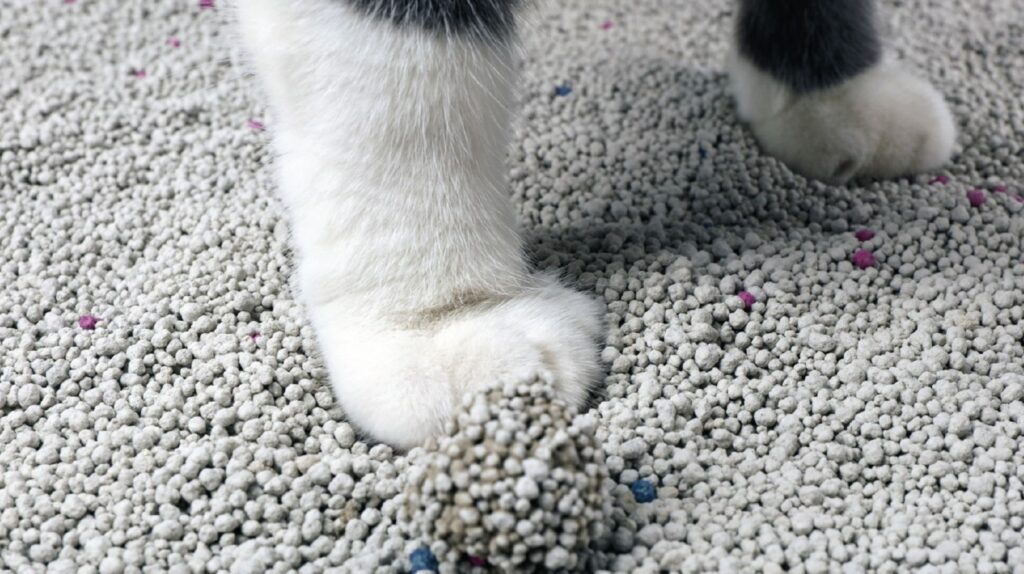
Performance research of cat litter
This section explains how well different cat litters work in real life, especially in terms of water absorption, clumping, odor control, and bacteria prevention.
2.1 Water Absorption
How much water cat litter can soak up is very important. Different kinds of litter have different abilities to absorb water.
One study found the order of absorption from best to worst was:
Tofu litter > Bentonite litter > Mixed litter > Wood litter > Paper litter > Crystal litter
Tofu litter had the highest absorption rate at 258.23%, while crystal litter only had 88.13%.
Another study showed that when bentonite is treated with sodium (a process called “sodium modification”), its water absorption improves a lot. One test showed it could absorb up to 436.5% after 2 hours.
2.2 Clumping Ability
Clumping Cat litter with good clumping can quickly wrap urine and feces, allowing them to form clumps and facilitate cleanup. While the cat litter is constantly consumed, it can be replenished at any time, without pouring out the whole pot, just dispose of the clumped cat litter. Cat litter with good clumping reduces processing time and prolongs the use time of cat litter. Qiao Bei proposed two methods that can improve the water absorption and agglomeration of domestic tofu cat litter, the first is to improve its water absorption and agglomeration by adding wood chips to the raw materials, and the tofu cat litter obtained through this method is improved in terms of water absorption and agglomeration compared with domestic cat litter. Another method is to mix domestic tofu cat litter raw materials with hot water at 90 °C for heat treatment, cool and freeze, and then crush them after drying to obtain the same powder as the original cat litter raw materials. The viscosity of the heat-treated tofu cat litter mixed with 275 ml of water increased from 6.4 mPa·s to 11.6 mPa·s. The gelatinization reaction of starch under the action of hot water can increase the viscosity of tofu cat litter. The increase in viscosity makes the cat litter agglomerate better and reduces the phenomenon of clumping
2.3 Odor Control
Since most cats live indoors, their pee and poop can make the house smell bad. Cat litter should help remove these smells.
Common stinky substances in cat waste include:
Urea, ammonia, hydrogen sulfide, indole, and more.
Ways to control odor:
-
Add activated charcoal:
One study showed that litter without charcoal only removed about 39% of ammonia and 32% of hydrogen sulfide.
But when the litter was made of 70% bentonite, 10% special stone powder, and 20% charcoal, it removed over 90% of both gases! -
Add probiotics (good bacteria):
These are safer and help remove bad smells naturally.
One study showed that plant-based litters did slightly better than tofu litter in odor control.
| Cat Litter Type | Main Ingredients | Advantages |
|---|---|---|
| Tofu-based & Bentonite Mixed Litter | Tofu, Bentonite | Good water absorption, removes smells well, makes little dust |
| Corn & Bentonite Mixed Litter | Tofu, Corn, Bentonite | Removes smells well, clumps quickly |
| 3-in-1 Mixed Cat Litter | Tofu, Bentonite, Mineral Particles | Clumps well, very low dust |
2.4 Bacteria Control
Good cat litter should prevent bacteria from growing, which can help keep cats from getting sick.
Some studies found:
-
Litter with a germ-killing chemical (polyhexamethylene biguanide) killed over 99% of E. coli and staph bacteria.
-
Tofu litter mixed with beneficial microbes also killed over 96% of harmful bacteria, including Klebsiella (a type of lung bacteria).
These antibacterial litters are becoming more popular and have strong market potential.
Improving Cat Litter Quality
3.1 Choosing Better Ingredients
The mix of raw materials affects the quality of the litter.
One study found that using 95% bentonite + 5% modified zeolite made litter that performed better than most local Chinese brands and was close to the quality of imported brands.
3.2 Improving the Production Process
One researcher used a special machine (a spray dryer with a fluidized bed) to make tofu litter into round particles.
She tested things like:
-
The amount of binder (glue-like material)
-
Spray nozzle height
-
Air pressure
-
Temperature
The best results were:
-
Water-to-binder ratio: 1:400
-
Temperature: 55°C
-
Water speed: 6 ml/min
The resulting tofu litter absorbed water quickly in 13.33 seconds, which met the expectations.
3.3 Adding Special Ingredients
Today, many new types of cat litter add extra materials to improve performance.
Examples:
-
Adding charcoal helps with smell and germs.
-
Adding probiotics helps reduce ammonia by 97% and hydrogen sulfide by 98%.
-
Some cat litters now include green tea powder, cherry blossom extract, lemon extract, and more to boost odor control and hygiene.
New types of litter even include health test particles. These particles change color if they detect blood in the urine, helping cat owners monitor their cat’s health.
Future Research and Development Trends
At present, there are still some problems in the research on cat litter, which still need to be improved. For example, the quality evaluation system of cat litter is relatively lacking and disordered, and we need to build a systematic evaluation system from the aspects of physical properties, sensory evaluation, nutritional indicators, functional evaluation, processing technology, safety and health evaluation, etc.; Substances added to cat litter can cause harm to the cat itself and even human safety. In response to such problems, when developing cat litter, new safety additives can be selected, and active ingredients from plants can be considered. When preparing mixed cat litter, it is necessary to master the optimal ratio and pay attention to the improvement of comprehensive performance. With the rapid development of the cat litter industry, the environmental protection of cat litter cannot be ignored. First of all, it is necessary to ensure that the cat litter discarded after use is degradable, and on this basis, it can be considered to be prepared into fertilizer to achieve waste utilization. At the same time, we can refer to the research direction of foreign cat litter, explore its extended function on the basis of improving the performance of cat litter, and solve more practical problems encountered in the process of raising cats. For example, by adding have the active substances preliminarily detect the physical health status of cats, assist in cultivating cats’ fixed-point excretion habits and improve cats’ aggressive behavior, etc., and expand the application value of cat litter in other fields. The future development direction of cat litter should tend to diversify to provide more convenience for cat families.
